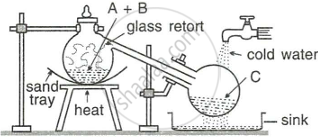Advertisements
Advertisements
Question
Ammonia is used in the Ostwald process.
Name the catalyst used in the process.
Solution
platinum gauze
APPEARS IN
RELATED QUESTIONS
Write a balanced chemical equation for the following:
Action of cold and dilute Nitric acid on Copper
Mention three important uses of nitric acid. Give the property of nitric acid involved in the use.
In which ratio reactants are taken in Ostwald process?
What happen when (Given balanced equation):
Nitric acid is added to washing soda and the resulting gas is passed through a freshly prepared lime water?
Complete and balance the following equation :
C + HNO3 → ___________
Complete and balance the following equation :
Fe + HNO3(conc.) → _____________
Complete and balance the following equation :
FeSO4 + NO + H2O → ______________
Write a balanced equation for the production of nitrogen dioxide using copper.
X, Y, and Z are three crystalline solids that are soluble in water and have common anion.
To help you to identify X, Y and Z, you are provided with the following experimental observations. Copy and complete the corresponding inferences in (a) to (e).
- A reddish-brown gas is obtained when X, Y, and Z are separately warmed with concentrated sulphuric acid and copper turning added to the mixture.
INFERENCE 1: The common anion is the ______ ion. - When X is heated, it melts and gives off only one gas which re-lights a glowing splint.
INFERENCE 2: The cation in X is either ______ or ______. - The action of heat on Y produces a reddish-brown gas and yellow residue which fuses with a glass of the test tube.
INFERENCE 3: The metal ion present in Y is the ______ ion. - When Z is heated, it leaves no residue. Warming Z with sodium hydroxide solution liberates a gas which turns moist red litmus paper blue.
INFERENCE 4: Z contains the ______ cation. - Write the equations for the following reactions:
- X and concentrated sulphuric acid (below 200°C). (One equation only for either of the cations given in INFERENCE 2)
- The action of heat on Y.
- Concentrated nitric acid is added to copper turnings kept in a beaker.
The figure given below illustrates the apparatus used in the laboratory preparation of nitric acid.

- Name A (a liquid), B (a solid), and C (a liquid). (Do not give the formulae).
- Write an equation to show how nitric acid undergoes decomposition.
- Write the equation for the reaction in which copper is oxidised by concentrated nitric acid.
